Frequency Dispersion of Love Waves in a Piezoelectric Nanofilm Bonded on a Semi-infinite Elastic Substrate
2015-11-01ZHANGSijiaGUBinZHANGHongbinPANRongyingAlamusiandFENGXiqiao
ZHANG Sijia, GU Bin,*, ZHANG Hongbin, PAN Rongying, Alamusi, and FENG Xiqiao
1 School of Manufacturing Science and Engineering, Southwest University of Science and Technology,Mianyang 621010, China2 School of Civil Engineering and Architecture, Hainan University, Haikou 570228, China3 Institute of Biomechanics and Medical Engineering, Department of Engineering Mechanics,Tsinghua University, Beijing 100084, China
Frequency Dispersion of Love Waves in a Piezoelectric Nanofilm Bonded on a Semi-infinite Elastic Substrate
ZHANG Sijia1, GU Bin1,*, ZHANG Hongbin2, PAN Rongying1, Alamusi1, and FENG Xiqiao3
1 School of Manufacturing Science and Engineering, Southwest University of Science and Technology,Mianyang 621010, China
2 School of Civil Engineering and Architecture, Hainan University, Haikou 570228, China
3 Institute of Biomechanics and Medical Engineering, Department of Engineering Mechanics,Tsinghua University, Beijing 100084, China
Research on the propagation of elastic waves in piezoelectric nanostructures is very limited. The frequency dispersion of Love waves in layered piezoelectric nanostructures has not yet been reported when surface effects are taken into account. Based on the surface elasticity theory, the propagation of Love waves with surface effects in a structure consisting of a nanosized piezoelectric film and a semi-infinite elastic substrate is investigated focusing on the frequency dispersion curves of different modes. The results show that under the electrically-open conditions, surface effects give rise to the dependence of Love wave dispersion on the film thickness when the thickness of the piezoelectric film reduces to nanometers. For a given wave frequency, phase velocity of Love waves in all dispersion modes exhibit obvious toward shift as the film thickness decreases or the surface parameters increase. Moreover, there may exist a cut-off frequency in the first mode dispersion below which Love waves will be evanescent in the structure due to surface effects. The cut-off frequency depends on the film thickness, the surface parameters and the bulk material properties.
surface effects, electrically-open, frequency dispersion, love wave, piezoelectric nanofilm
1 Introduction*
Piezoelectric materials have been widely used in smart devices or systems for non-destructive detection and wave-guide functions due to the inherent electromechanical coupling effects. For these applications, the propagation and diffraction of elastic waves in various piezoelectric structures are a major concern and have been extensively investigated[1-3]. For example, GU, et al[4], addressed the scattering of Love waves by an interface crack between a piezoelectric layer and an elastic substrate by using the integral transform and singular integral equation techniques. Considering the inhomogeneous initial stress, JIN, et al[5],examined the propagation of Love waves in a piezoelectric layered structure. The effects of functionally graded properties, dissipation, and viscosity on Love wave propagation in piezoelectric structures have been systematically studied by DU and co-workers[6-9]. LU and HE[10]analyzed the properties of Love waves in layered piezoelectric structures. QIAN and HIROSE[11]revealed that two types of transverse surface waves may exist in piezoelectric/elastic layered structures, depending on the velocities of the bulk transverse shear waves in the piezoelectric and elastic mediums. Recently, MANNA, et al[12], studied the propagation of Love waves in a piezoelectric layer overlying an inhomogeneous half-space.
With the rapid development of nanotechnology,nanosized piezoelectric elements and devices have been widely used in MEMS(Micro-Electro-Mechanical Systems)and NEMS(Nano-Electro-Mechanical Systems). When the characteristic sizes of structures reduce to nanometers,surface effects may have a great impact on the wave propagation and dispersion in both elastic and piezoelectric structures. Taking into account surface effects according to the surface elasticity theory of GURTIN, et al[13-14], WANG and co-workers analyzed the diffraction of plane compressional waves by a nanosized spherical inclusion[15],a cylindrical nano-inclusion[16], and an array of nanosized cylindrical holes[17]in an infinite elastic medium. FANG, et al[18], investigated the effect of interfacial properties on the dynamic stresses when plane compressional waves are diffracted by two interacting cylindrical nanosized inhomogeneities. Using the surface elasticity theory of piezoelectric materials developed by PAN, et al[19], FANG,et al, considered the scattering of anti-plane electro-elastic waves by a nanofiber[20]and two interacting nanofibers[21]in a piezoelectric medium. Moreover, ZHANG, et al[22],examined the influence of surface effects on the dispersion of compressional waves by a piezoelectric nanocylinder. As for piezoelectric wave-guide structures, ZHANG and CHEN[23]investigated the propagation of transverse shear waves in an infinite piezoelectric nanoplate with surface effects. Using a method different from the surface elasticity theory, CHEN, et al[24], found that the dispersion relation of transverse shear waves in a nanosized piezoelectric cylinder is greatly affected by surface effects. To date,however, surface effects on the elastic wave propagation in piezoelectric structures are still unclear.
Piezoelectric nanofilms are ideal candidates for nanoelectro-mechanical actuators and resonators, which possess huge potentials in the fields of physics and biologics, such as the detection of quantum ground state,the small scale electromechanical energy harvesting and the identification of small molecules[25-26]. Using the nonlocal elasticity theory, ASEMI, et al[27], carried out the nonlinear vibration analysis of piezoelectric nanoresonator made of ultra-thin AlN films and applied to nanoscale mass detection[28]. As piezoelectric nanofilms are often deposited on a substrate of different physical properties in performances, it is vital to understand the wave dispersion in the piezoelectric nanofilm adhered to an elastic substrate. To the author's knowledge, research on wave propagation with surface effects in layered piezoelectric nanofilms has not yet been reported.
In this work, we considered a kind of layered piezoelectric structures consisting of a nanosized piezoelectric film bonded on a semi-infinite elastic substrate. The propagation of Love waves in such a smart structure was investigated by using the surface elasticity theory. Surface effects were taken into account on the free surface of the piezoelectric film and its interface with the substrate. Under the electrically-open conditions, the features of the frequency dispersion of Love waves are revealed.
2 Statement of The Problem
We considered a layered structure consisting of a flat piezoelectric film of thickness h bonded to a semi-infinite elastic substrate, as shown in Fig. 1. Referring to the Cartesian coordinate system (X, Y, Z), the piezoelectric film is polarized in the z direction and the incident Love wave propagates along the x direction. The surface effects on the free surface of the piezoelectric film and its interface with the substrate were examined. The surface elasticity theory originally established by GURTIN, et al[13-14]and generalized for piezoelectric materials by PAN, et al[19]is adopted to account for surface effects. In this theory,surface effects only change the boundary conditions on the free surface and the interface while the basic equations in the bulk material, such as the geometric equations,equilibrium equations and constitutive equations are the same as in the classical elasticity theory.
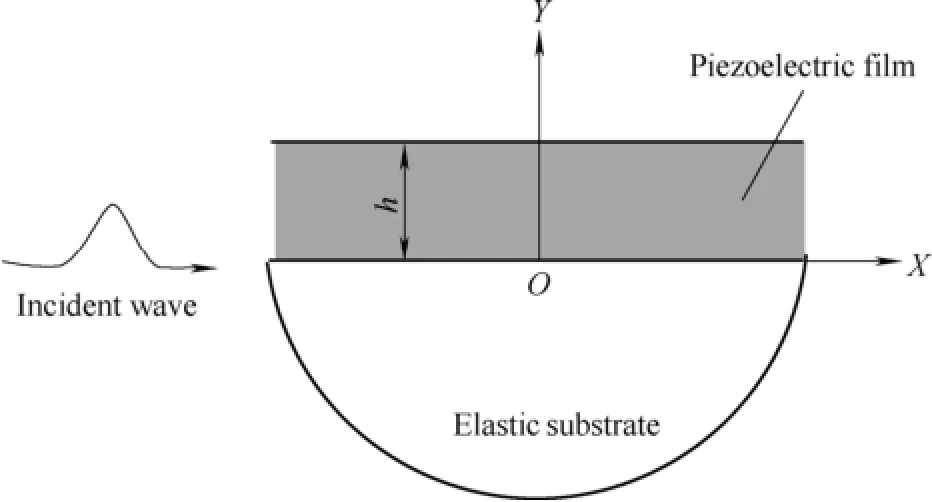
Fig. 1. Configuration of a piezoelectric film bonded with a semi-infinite elastic substrate
Since the Love wave is a type of anti-plane shear surface wave, the displacement and the electric fields in the structure have the following forms:

where superscript “e” denotes the quantities related to the elastic substrate. ui( i=x, y, z) and φ stands for the displacements and the electric potential, respectively. According to Eq. (1), the constitutive equations of the piezoelectric film and the substrate can be written as

where σzαand Dα(α=x, y) are the stress components and the electric displacement components. c44, e15and k11represent the elastic stiffness, the piezoelectric and the dielectric permeability coefficients, respectively. Moreover,the equilibrium equations read:

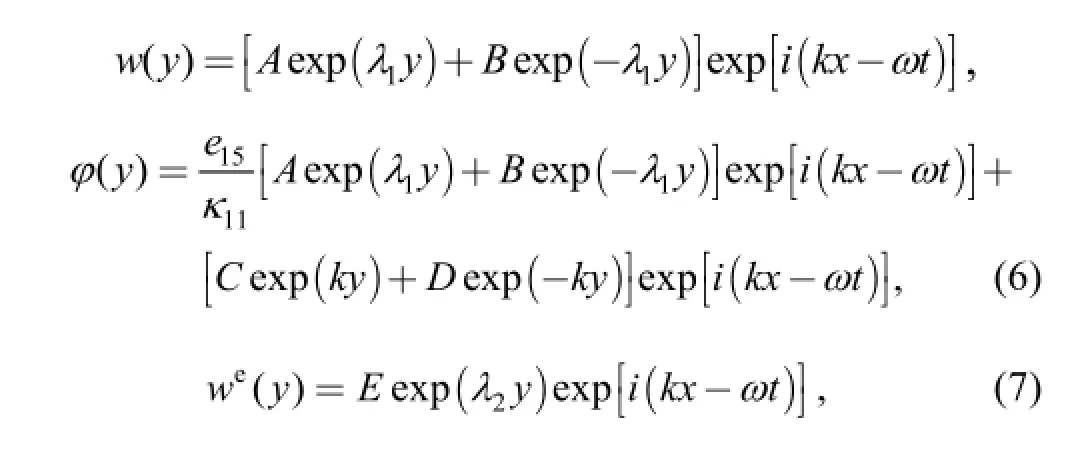

The boundary conditions on the upper surface of the thin film and the film-substrate interface are required to determine the unknown constants A, B, C, D and E. When considering surface effects, the stress and electric displacement are no longer continuous cross a surface/interface. In terms of the surface elasticity theory for piezoelectric materials, surface stresses and surface electric displacements are introduced in a surface layer which has zero thickness and is perfectly bonded with the bulk material. Therefore, the displacement and the electric potential are still continuous cross a surface/interface. And the stress and electric displacement boundary conditions at the surface/interface can be derived from the balance conditions of forces and electric charges. They can be expressed as[19]

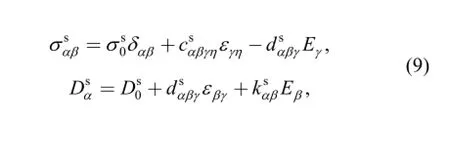




Substituting Eqs. (2), (3), (6), (7), (9) into Eqs. (10), (11)and following the similar procedure in Ref. [4], the equation of the frequency dispersion of Love waves is deduced as
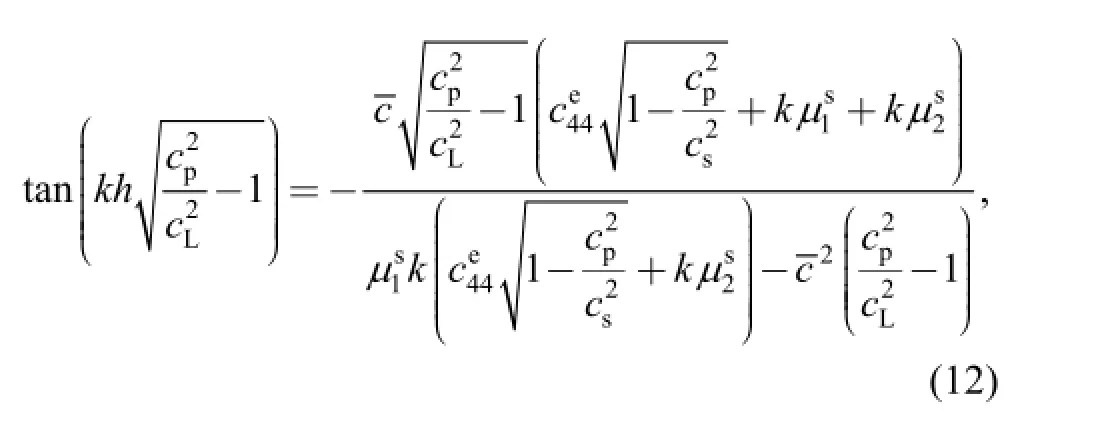

3 Numerical Results and Discussion


Table 1. Material properties of the PZT-4 and the Aluminum

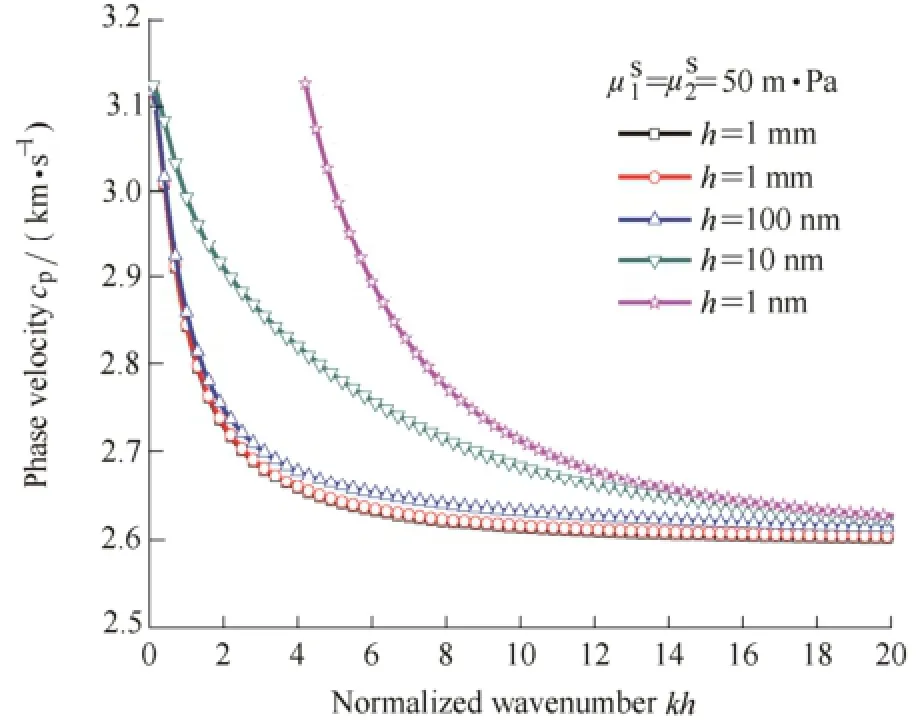
Fig. 2. Frequency dispersion curves of the first mode for different film thickness h when50 mPa
It is seen that when the film thickness is greater than 1 micrometer, the dispersion relation is independent of the film thickness and the solution can be well captured by the classical wave theory without surface effects. That is, the dispersion curves when h=1 mm are identical to those when surface effects are absent. Thus, we may conclude that surface effects have negligible effects on the dispersion relations not until the film thickness shrinks to nanometers(e.g., h<100 nm). At nanoscale, however, surface effects give rise to remarkable changes in the dispersion curves when h varies from 100 nm to 1 nm. First of all, the frequency dispersion shows a distinct dependence on the thickness h when surface effects are taken into account. For a given wavenumber k, phase velocities of all dispersion modes, which satisfy cL<cp<cs, increase with the decrease in the film thickness. In particular, Fig. 2 shows that when the film thickness is small (e.g., h=1 nm), the phase velocity of the first mode dispersion appears only after the wavenumber is larger than a certain value (e.g.,kh≥4.3). This indicates that there may exist a cut-off frequency for Love waves to propagate in the considered structures when surface effects are taken into account. Consequently, Love waves will vanish if the frequency is lower than the cut-off frequency. Moreover, the value of the cut-off frequency is dependent on the film thickness h and increases with the decrease in h.

Fig. 3. Frequency dispersion curves of the second mode for different film thickness h when


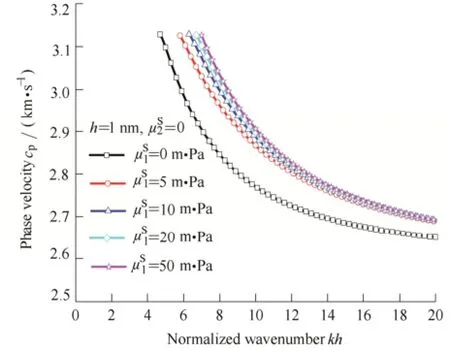
Fig. 5. Frequency dispersion curves of the second mode for different surface parameter on the free surfacewhen
4 Conclusions
(1) With the consideration of surface effects, the dispersion of Love waves shows a distinct dependence on the film thickness and the surface constants. This is quite different from that in the classical wave theory where the dispersion relation only relies on the bulk material properties.
(2) For a certain wave frequency, decreasing the film thickness or increasing the values of the surface parameters can lead to a higher phase velocity of Love waves.
(3) A cut-off frequency arises from surface effects in the fundamental mode of Love wave dispersion, below which Love waves cannot propagate in the film-substrate structures. Such cut-off frequency is dictated by the film thickness, the surface parameters as well as the bulk material properties.
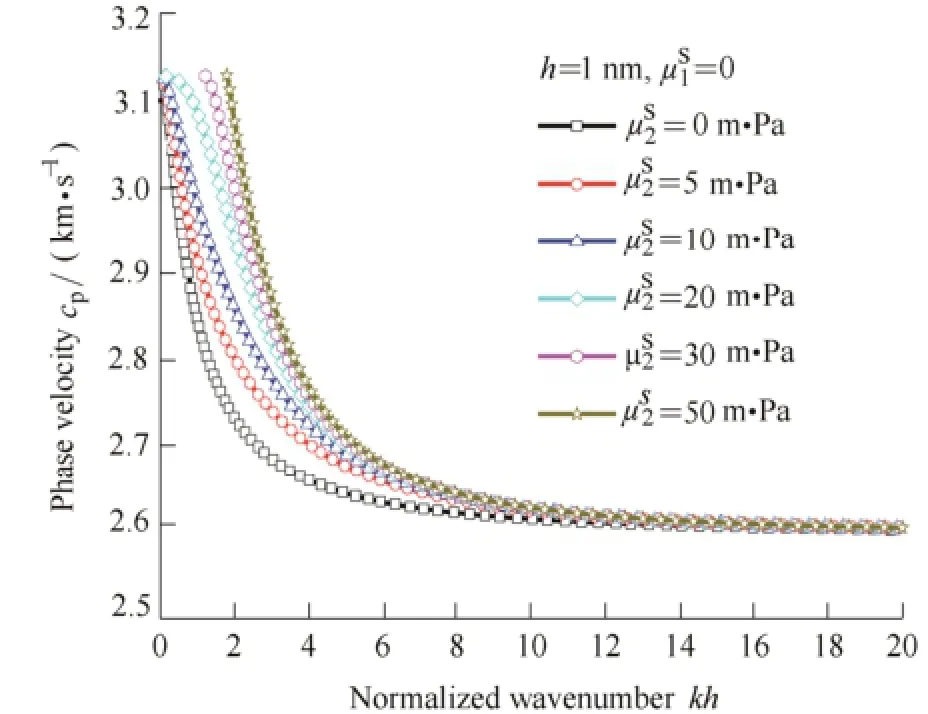
Fig. 6. Frequency dispersion curves of the first mode for different surface parameter on the interfacewhen
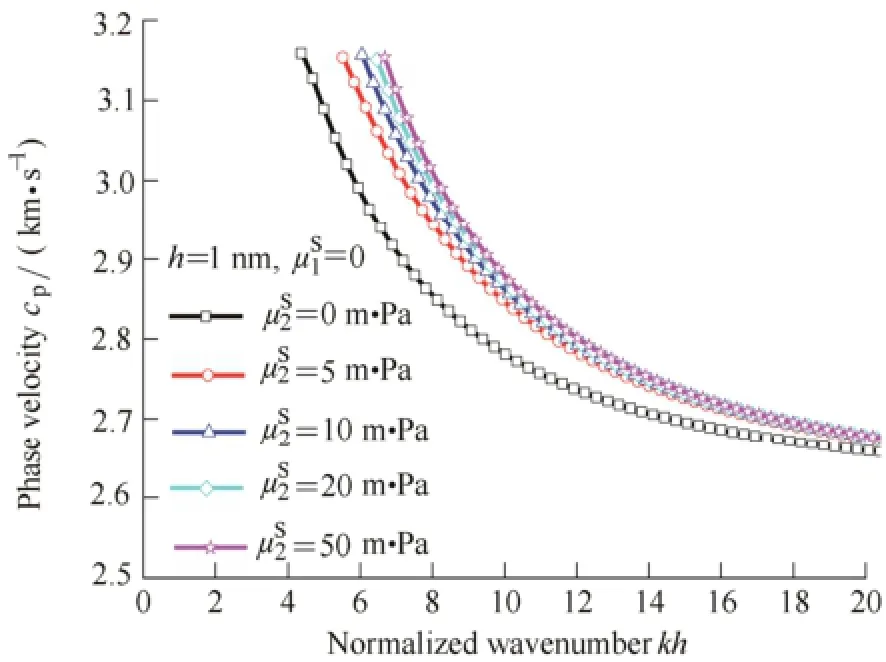
Fig. 7. Frequency dispersion curves of the secondmode for different surface parameter on the interface when
[1] GU Bin, YU Shouwen, FENG Xiqiao. Elastic wave scattering by an interface crack between a piezoelectric layer and an elastic substrate[J]. International Journal of Fracture, 2002, 116(2): 29-34.
[2] YANG Jiashi, WANG Ji. Dynamic anti-plane problems of piezoceramics and applications in ultrasonics-A review[J]. Acta Mechanica Solida Sinica, 2008, 21(3): 207-220.
[3] PANG Yu, WANG Yuesheng, LIU Jinxi, et al. Reflection and refraction of plane waves at the interface between piezoelectric and piezomagnetic media[J]. International Journal of Engineering Science, 2009, 45: 1099-1110.
[4] GU Bin, YU Shouwen, FENG Xiqiao, et al. Scattering of love waves by an interface crack between a piezoelectric layer and an elastic substrate[J]. Acta Mechanica Solida Sinica, 2002, 15(2): 111-118.
[5] JIN Feng, QIAN Zhenhua, WANG Zikun, et al. Propagation behavior of Love waves in a piezoelectric layered structure with inhomogeneous initial stress[J]. Smart Materials Structures, 2005,14(4): 515.
[6] DU Jianke, JIN Xiaoying, WANG Ji, et al. Love wave propagation in functionally graded piezoelectric material layer[J]. Ultrasonics,2007, 46(1): 13-22.
[7] DU Jianke, XIAN Kai, WANG Ji, et al. Propagation of Love waves in prestressed piezoelectric layered structures loaded with viscous liquid[J]. Acta Mechanica Solida Sinica, 2008, 21(6): 542-548.
[8] DU Jianke, XIAN Kai, WANG Ji, et al. Love wave propagation in piezoelectric layered structure with dissipation[J]. Ultrasonics, 2009,49(2): 281-286.
[9] DU Jianke, CHENG Xiaoyu, WANG Ji, et al. The effect of viscosity on Love waves in piezoelectric structures[C]//Proceedings of the 2009 IEEE International Ultrasonics Symposium, Rome, Italy,September 20-23, 2009: 2024-2026.
[10] LIU Jiansheng, HE Shitang. Properties of Love waves in layered piezoelectric structures[J]. International Journal of Solids and Structures, 2010, 47(2): 169-174.
[11] QIAN Zhenghua, HIROSE S. Theoretical validation on the existence of two transverse surface waves in piezoelectric/elastic layered structures[J]. Ultrasonics, 2012, 52: 442-446.
[12] MANNA S, KUNDU S, GUPTA S. Love wave propagation in a piezoelectric layer overlying in an inhomogeneous elastic half-space[J]. Journal of Vibration and Control, 2013,1077546313513626.
[13] GURTIN M E, MURDOCH A I. A continuum theory of elastic material surfaces[J]. Archive for Rational Mechanics Analysis, 1975,57: 291-323.
[14] GURTIN M E, WEISSMÜLLER J, LARCHE F. A general theory of curved deformable interfaces in solids at equilibrium[J]. Philisophical Magazine A, 1995, 78(5): 1093-1109.
[15] WANG Gangfeng, FENG Xiqiao, YU Shouwen. Interface effect on the diffraction of plane compressional waves by a nanosized spherical inclusion[J]. Journal of Applied Physics, 2007, 102: 043533.
[16] RU Y, WANG Gangfeng, WANG T J. Diffraction of elastic waves and stress concentration near a cylindrical nano-inclusion incorporating surface effect[J]. Journal of Vibration and Acoustics,2009, 131: 061011-1.
[17] ZHANG Q F, WANG Gangfeng, SCHIAVONE P. Diffraction of plane compressional waves by an array of nanosized cylindrical holes[J]. Journal of Applied Mechanics, 2011, 78: 021003-1.
[18] FANG Xueqian, LIU Jinxi, YANG Shaopu, et al. Effect of surface/interface on the dynamic stress of two interacting cylindrical nano-inhomogeneities under compressional waves[J]. Thin Solid Films, 2010, 518(23): 6938-6944.
[19] PAN Xiahui, YU Shouwen, FENG Xiqiao. A continuum theory of surface piezoelectricity for nanodielectrics[J]. Science China: Physics, Mechanics & Astronomy, 2011, 54: 564-573.
[20] FANG Xueqian, LIU Jinxi. Dynamic stress and electric displacement around a nano-fiber in piezoelectric nanocomposites under electro-elastic waves[J]. Philosophical Magazine. Letters,2011, 91: 621-631.
[21] FANG Xueqian, LIU Jinxi, DOU Lihua, et al. Dynamic strength around two interacting piezoelectric nano-fibers with surfaces/ interfaces in solid under electro-elastic waves[J]. Thin Solid Films,2012, 520: 3587-3592.
[22] ZHANG L L, LIU Jinxi, FANG Xueqian, et al. Surface effects on the scattering of compressional waves by a piezoelectric nanocylinder[J]. Journal of Applied Physics, 2014, 115(24): 244305.
[23] ZHANG Chunli, CHEN Weiqiu, ZHANG C. On propagation of anti-plane shear waves in piezoelectric plates with surface effect[J]. Physics Letters A, 2012, 376(45): 3281-3286.
[24] CHEN Weiqiu, WU B, ZHANG Chunli, et al. On wave propagation in anisotropic elastic cylinders at nanoscale: surface elasticity and its effect[J]. Acta Mechanica, 2014, 225: 2743-2760.
[25] EOM K, PARK H S, YOON D S, et al. Nanomechanical resonators and their applications in biological/chemical detection: nanomechanics principles[J]. Physics Rerports, 2011, 503: 115-163.
[26] FANG Xueqian, LIU Jinxi, GUPTA V. Fundamental formulations and recent achievements in piezoelectric nano-structures: a review[J]. Nanoscale, 2013, 5: 1716-1726.
[27] ASEMI S R, FARAJPOUR A, MOHAMMADI M. Nonlinear vibration analysis of piezoelectric nanoelectromechanical resonators based on nonlocal elasticity theory[J]. Composite Structures, 2014,116: 703-712.
[28] ASEMI H R, ASEMI S R, FARAJPOUR A, et al. Nanoscale mass detection based on vibrating piezoelectric ultrathin films under thermo-electro-mechanical loads[J]. Physica E: Low-dimensional Systems and Nanostructures, 2015, 68: 112-122.
[29] MILLER R E, SHENOY V B. Size-dependent elastic properties of nanosized structural elements[J]. Nanotechnology, 2000, 11: 139-147.[30] SHENOY V B. Size-dependent rigidities of nanosized torsional elements[J]. International Journal of Solids and Structures, 2002,39: 4039-4052.
Biographical notes
ZHANG Sijia, born in 1992, is currently a graduate candidate at School of Manufacturing Science and Engineering, Southwest University of Science and Technology, China.
E-mail: 1033263552@qq.com
GU Bin, born in 1975, is currently a professor at School of Manufacturing Science and Engineering, Southwest University of Science and Technology, China. He received his PhD degree from Tsinghua University, China in 2002. His research interest covers fracture mechanics, smart materials and multi-scale computational method.
E-mail: gubin96@tsinghua.org.cn; gubin@swust.edu.cn
ZHANG Hongbin, born in 1973, is currently a lecturer at School of Civil Engineering and Architecture, Hainan University, China. He received his master degree from Tsinghua University, China in 1999. His research focuses on modeling and numerical simulation on multi-physics coupling field problems.
Tel: +898-66278116; E-mail: zmmzhb@126.com
PAN Rongying, born in 1991, is currently a graduate candidate at School of Manufacturing Science and Engineering, Southwest University of Science and Technology, China.
E-mail: 15390278646@163.com
Alamusi, born in 1978, is currently an associate professor at School of Manufacturing Science and Engineer, Southwest University of Science and Technology, China. He received his PhD degree from Chiba University, Japan in 2013. His research is mainly on the development and applications of functional nanocomposites.
E-mail: alamuz@126.com
FENG Xiqiao, born in 1968, is currently the director of Institute of Biomechanics and Medical Engineering, Tsinghua University,China. He received his PhD degree from Tsinghua University,China in 1995. His research fields include biological mechanics,micro mechanics of cell damage and fracture mechanics.
E-mail: fengxq@tsinghua.edu.cn
10.3901/CJME.2015.0709.090, available online at www.springerlink.com; www.cjmenet.com; www.cjme.com.cn
* Corresponding author.
E-mail: gubin96@tsinghua.org.cn; gubin@swust.edu.cn
Supported by National Natural Science Foundation of China(Grant No. 11372261), Excellent Young Scientists Supporting Project of Science and Technology Department of Sichuan Province, China(Grant No. 2013JQ0030), Supporting Project of Department of Education of Sichuan Province, China(Grant No. 2014zd3132), Opening Project of Key Laboratory of Testing Technology for Manufacturing Process, Southwest University of Science and Technology-Ministry of Education, China(Grant No. 12zxzk02), Fund of Doctoral Research of Southwest University of Science and Technology, China(Grant No. 12zx7106), and Postgraduate Innovation Fund of Southwest University of Science and Technology,China(Grant No. 15ycx128)
© Chinese Mechanical Engineering Society and Springer-Verlag Berlin Heidelberg 2015
May 28, 2015; revised June 25, 2015; accepted July 9, 2015
杂志排行
Chinese Journal of Mechanical Engineering的其它文章
- Influence of Alignment Errors on Contact Pressure during Straight Bevel Gear Meshing Process
- Shared and Service-oriented CNC Machining System for Intelligent Manufacturing Process
- Material Removal Model Considering Influence of Curvature Radius in Bonnet Polishing Convex Surface
- Additive Manufacturing of Ceramic Structures by Laser Engineered Net Shaping
- Kinematics Analysis and Optimization of the Fast Shearing-extrusion Joining Mechanism for Solid-state Metal
- Springback Prediction and Optimization of Variable Stretch Force Trajectory in Three-dimensional Stretch Bending Process
